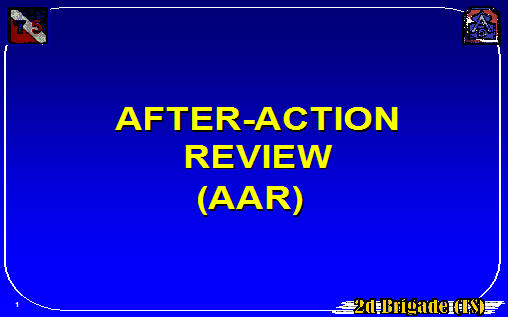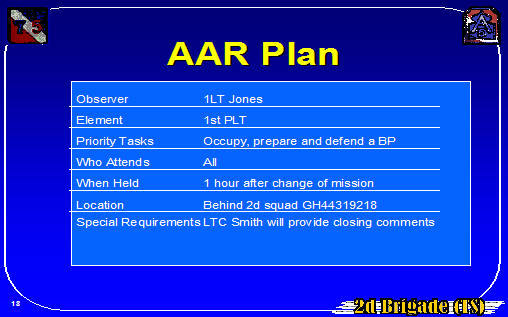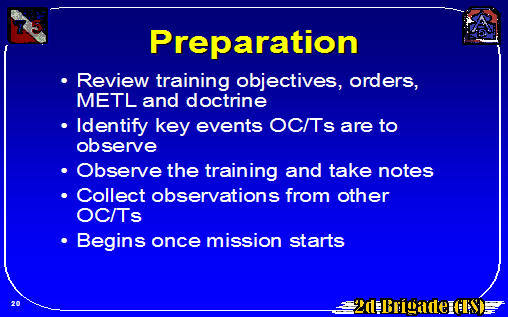After Action Review AAR
Click here to download the presentation.



AFTER-ACTION REVIEW
(AAR)
Agenda
Definition
Objective
Purpose
Key points
Guidelines
Formal AAR
Informal AAR
The four phases of an AAR
Summary
Definition
An AAR is a professional discussion of an event, focused on performance standards, that enables soldiers to discover for themselves What happened, Why it happened and How to sustain strengths and improve on weaknesses.
It is a tool leaders and units can use to get maximum benefit from every mission or task.
Objective
The objective of an AAR is to improve individual and collective task performance by providing immediate feedback about how the training or tasks could have been done better.
Purpose
Guide the unit towards achieving training objectives
Identify lessons learned so they can be applied to subsequent training or task performance
Increase confidence in unit leaders
Increase proficiency of all participants
AAR Key Points
Involve all participants
Are conducted during or immediately after each event
Focus on intended training objective
…� Focus on soldier, leader and unit performance
AAR Key Points (cont)
Use open-ended questions
Are related to specific standards
Determine strengths and weaknesses
Link performance to subsequent training
Guidelines
Maintain order and discipline
Emphasize the goal is to achieve Army standards
Make AARs positive in nature
Avoid—
Lecturing
Critiquing, criticizing or judging performance
Embarrassing soldiers or leaders
Comparing units
Formal
External OC/Ts
Takes more time
Complex training aids
Scheduled beforehand
Conducted when best supported
Conducted to gain maximum training benefit
Normally for Platoon-level and above
Informal
Informal (cont)
Uses standard AAR format
Limited resources
Normally for soldier (leader), crew, squad and platoon-level training
Supports higher-level formal AAR
Held prior to higher-level formal AAR
Phases of the AAR
Planning
Preparation
Conduct
Follow-up
Enabling Learning Objective
Action : Identify the steps followed during the After Action Review planning phase
Conditions : In a classroom environment and access to TC 25-20
Standard : Successfully describe the steps followed during the planning phase of the AAR
Planning
Establish objectives for the AAR
Select and train qualified OC/Ts
Review the training and evaluation plan, Army Training and Evaluation Program (ARTEP), mission training plans (MTPs) and soldier training publications (STPs)
Determine when AARs will occur and identify participants
AAR Plan
Enabling Learning Objective
Action : Identify the steps followed during the After Action Review preparation phase
Conditions : In a classroom environment and access to TC 25-20
Standard : Correctly describe the steps followed during the preparation phase of the AAR
Preparation
Review training objectives, orders, METL and doctrine
Identify key events OC/Ts are to observe
Observe the training and take notes
Collect observations from other OC/Ts
Begins once mission starts
AAR Observation Worksheet Example
Preparation (cont)
Organize observations (Identify key discussion or teaching points)
Gather observations from OPFOR representative
Recon and prepare the selected AAR site
Conduct rehearsals
Discussion Techniques
Leading/thought-provoking questions
Have unit members describe what happened in their own words
Explore alternative courses of action
Avoid detailed examination of events not directly related to major training objectives
Enabling Learning Objective
Action : Identify the steps followed during the conduct of the AAR
Conditions : In a classroom environment and access to TC 25-20
Standard : Correctly identify the steps followed during the conduct of the AAR
Format of the AAR
Introduction and AAR rules of engagement (ROE)
Review of objectives and intent
Training objectives
Commander’s mission/intent (what was supposed to happen)
OPFOR commander’s mission/intent
Relevant doctrine, tactics, techniques and procedures (TTPs)
Summary of recent events (what happened)
Format of the AAR (cont)
Discussion of key issues
Chronological order of events
Battlefield operating systems (Co level)
Key events/themes/issues
Plan, Prep and Execute (technique)
Format of the AAR (cont)
Key Leader Assessment
Format of the AAR (cont)
Discussion of force protection/ safety
Closing comments
Enabling Learning Objective
Action : Identify the steps followed during the follow up phase of the After Action Review
Conditions : In a classroom environment and access to TC 25-20
Standard : Correctly identify the steps followed during the follow up phase of the AAR
Follow-up
Identify tasks requiring retraining
Fix the problem – retrain
Revise SOPs, integrate into future training plans
Use to assist in making assessment